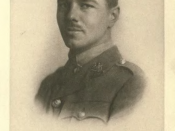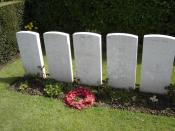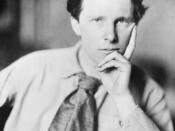Comparison essay: "Dulce et Decorum Est" and "The Soldier"
"Dulce et Decorum Est" by Wilfred Owen and "The Soldier" by Rupert Brooke are two poems about war. The two poets have different attitudes to war. They use similar and different techniques and ideas to convey there attitudes to war.
The pace of "Dulce Decorum Est" is similar in some ways to "The Soldier" but is also very different in others. The pace of "The Soldier" the pace is consistently slow and gentle. Rupert Brooke uses punctuation and calm language to make this slow and consistent pace. For example, "A dust whom England bore, shaped made aware, Gave, once, her flowers to love, her ways to roam." Rupert Brooke has used many commas in this sentence to keep a slow pace. He uses very calm language for example "flowers" and "love." This slow and gentle pace is used to convey a very positive attitude to war.
In "Dulce Decorum Est" like "The Soldier" the pace begins slowly. Then suddenly at the beginning of the second stanza the pace dramatically increases, and then the pace gradually slows down to the end. Wilfred Owen like Rupert Brooke uses punctuation and dramatic language to slow and speed up the pace. For example, "Gas! Gas! Quick boys!" Wilfred Owen used the exclamation mark to speed up the pace and also the word "Quick" speeds up the pace. Wilfred Owen uses pace to convey a negative attitude towards war. Having a slow or fast pace is important because it sets the rhythm and tone of the poem.
The tone of "Dulce et Decorum Est" and the tone of "The Soldier" are very different. The tone of "The Soldier" is very positive and patriotic which conveys a positive approach to war.



Little suggestion.....
Overall, this is a good essay! But maybe if you could deeply explain the use of poetic techniques, such as saying what the poet wan to emphasis by using this metaphor. And giving more examples and explaining more will make your essay perfect.
1 out of 1 people found this comment useful.